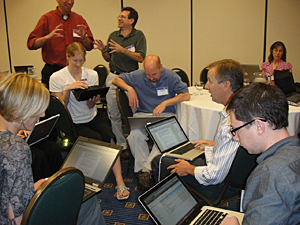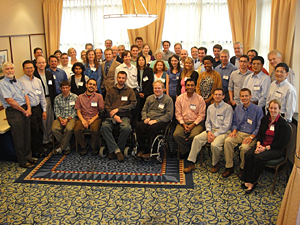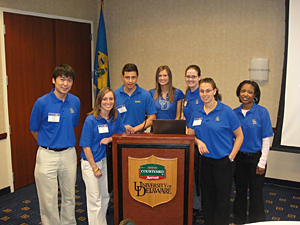

ADVERTISEMENT
- Rozovsky wins prestigious NSF Early Career Award
- UD students meet alumni, experience 'closing bell' at NYSE
- Newark Police seek assistance in identifying suspects in robbery
- Rivlin says bipartisan budget action, stronger budget rules key to reversing debt
- Stink bugs shouldn't pose problem until late summer
- Gao to honor Placido Domingo in Washington performance
- Adopt-A-Highway project keeps Lewes road clean
- WVUD's Radiothon fundraiser runs April 1-10
- W.D. Snodgrass Symposium to honor Pulitzer winner
- New guide helps cancer patients manage symptoms
- UD in the News, March 25, 2011
- For the Record, March 25, 2011
- Public opinion expert discusses world views of U.S. in Global Agenda series
- Congressional delegation, dean laud Center for Community Research and Service program
- Center for Political Communication sets symposium on politics, entertainment
- Students work to raise funds, awareness of domestic violence
- Equestrian team wins regional championship in Western riding
- Markell, Harker stress importance of agriculture to Delaware's economy
- Carol A. Ammon MBA Case Competition winners announced
- Prof presents blood-clotting studies at Gordon Research Conference
- Sexual Assault Awareness Month events, programs announced
- Stay connected with Sea Grant, CEOE e-newsletter
- A message to UD regarding the tragedy in Japan
- More News >>
- March 31-May 14: REP stages Neil Simon's 'The Good Doctor'
- April 2: Newark plans annual 'wine and dine'
- April 5: Expert perspective on U.S. health care
- April 5: Comedian Ace Guillen to visit Scrounge
- April 6, May 4: School of Nursing sponsors research lecture series
- April 6-May 4: Confucius Institute presents Chinese Film Series on Wednesdays
- April 6: IPCC's Pachauri to discuss sustainable development in DENIN Dialogue Series
- April 7: 'WVUDstock' radiothon concert announced
- April 8: English Language Institute presents 'Arts in Translation'
- April 9: Green and Healthy Living Expo planned at The Bob
- April 9: Center for Political Communication to host Onion editor
- April 10: Alumni Easter Egg-stravaganza planned
- April 11: CDS session to focus on visual assistive technologies
- April 12: T.J. Stiles to speak at UDLA annual dinner
- April 15, 16: Annual UD push lawnmower tune-up scheduled
- April 15, 16: Master Players series presents iMusic 4, China Magpie
- April 15, 16: Delaware Symphony, UD chorus to perform Mahler work
- April 18: Former NFL Coach Bill Cowher featured in UD Speaks
- April 21-24: Sesame Street Live brings Elmo and friends to The Bob
- April 30: Save the date for Ag Day 2011 at UD
- April 30: Symposium to consider 'Frontiers at the Chemistry-Biology Interface'
- April 30-May 1: Relay for Life set at Delaware Field House
- May 4: Delaware Membrane Protein Symposium announced
- May 5: Northwestern University's Leon Keer to deliver Kerr lecture
- May 7: Women's volleyball team to host second annual Spring Fling
- Through May 3: SPPA announces speakers for 10th annual lecture series
- Through May 4: Global Agenda sees U.S. through others' eyes; World Bank president to speak
- Through May 4: 'Research on Race, Ethnicity, Culture' topic of series
- Through May 9: Black American Studies announces lecture series
- Through May 11: 'Challenges in Jewish Culture' lecture series announced
- Through May 11: Area Studies research featured in speaker series
- Through June 5: 'Andy Warhol: Behind the Camera' on view in Old College Gallery
- Through July 15: 'Bodyscapes' on view at Mechanical Hall Gallery
- More What's Happening >>
- UD calendar >>
- Middle States evaluation team on campus April 5
- Phipps named HR Liaison of the Quarter
- Senior wins iPad for participating in assessment study
- April 19: Procurement Services schedules information sessions
- UD Bookstore announces spring break hours
- HealthyU Wellness Program encourages employees to 'Step into Spring'
- April 8-29: Faculty roundtable series considers student engagement
- GRE is changing; learn more at April 15 info session
- April 30: UD Evening with Blue Rocks set for employees
- Morris Library to be open 24/7 during final exams
- More Campus FYI >>
9:21 a.m., June 29, 2010----The Biomechanics Priorities Conference brought 55 scientists from institutions across the United States and Australia to the University of Delaware from June 9-11 to help develop a roadmap for biomechanics research for the next decade.
The conference was sponsored by the National Institutes of Health (NIH) through the National Center for Medical Rehabilitation Research and the National Institute for Biomedical Imaging and Bioengineering. Support was also provided by the UD College of Health Sciences.
A priorities conference is a participant-centric workshop that promotes identification, refinement, documentation, dissemination, and prioritization of recommendations for accelerating advancements in a given field.
The conference format was originally developed at NIH in the mid-1990s. Irene Davis, professor in UD's Department of Physical Therapy, and Steven Stanhope, professor in the Department of Kinesiology and Applied Physiology, recently enhanced the format to create the Delaware Priorities Conference model.
One of their refinements was to make the meeting entirely paperless. Alex Razzook, a graduate student in UD's Biomechanics and Movement Science Program, developed a participant communication and document-sharing model system using Gmail and Google Docs.
“Watching a team of six experts from around the world simultaneously edit one online document in Google Docs was a thrilling experience,” Stanhope says. “We all entered the conference as concerned skeptics and emerged as online document-sharing converts.”
The meeting began with keynote presentations addressing four domains: cell/tissue mechanics, joint mechanics, limb/whole body mechanics, and functional outcomes. Participants were then organized into small groups to develop priority statements within and across these domains. The statements were discussed and refined throughout the meeting.
On the last day of the meeting, the 41 final priority statements were scored by all of the participants and ranked based on several factors, including significance and potential impact.
In addition, a number of central themes important to advancing the field were identified. One focused on the importance of advancing clinical research via the integration of basic scientists and engineers with clinicians, and another emphasized the need to enhance our ability to monitor subjects/patients outside the laboratory environment.
Finally, while many of the priorities focused on issues related to rehabilitation, the need to address overall musculoskeletal health and prevention of injuries was identified as an important future focus area.
According to Davis, a final report will be submitted to NIH and made available to other related societies. This summary will also be published in the Journal of Biomechanics.
“Overall, participants enjoyed the format of the meeting and felt that the outcome would have a positive impact on future biomechanics research,” she said.
The conference was held at Marriott's Courtyard Newark-University of Delaware hotel on campus. “Attendees were so impressed with the facilities and service at the hotel that we've already had some inquiries about holding future priorities conferences here,” Stanhope said.
A copy of the conference summary and other conference-related materials will be posted on the meeting website as they become available.
Article by Diane Kukich



